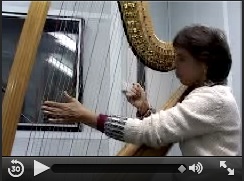Point of No Return - 1962


John Lennon uttered those famous words prior to playing the only Beatles song, “Come Together,” that would grace the setlist of his 1972 charity concert at Madison Square Garden. As John Lennon of 1972 was breaking away from his Beatle past, likewise, the Sinatra of 1961 was breaking away from his storied Capitol past and had, indeed, already released multiple LPs and singles on his own Reprise label, so it makes sense that he would approach the sessions for Point of No Return a little like a man approaches going to finalize his divorce: He’s got to see his ex-love one last time, and it’s going to be uncomfortable, but it needs to be seen through, so let’s get it over with.
Sinatra’s Capitol divorce court offered express service, apparently, as the album was recorded more quickly than any other: 12 songs in two days -- no beating around the bush. Under the circumstances, one might expect the album to be a throwaway, something not worth listening to, but indeed, although flawed in spots, it is, on the whole, just the opposite, and one could make the case that the Capitol album that earned the title of Contractual Obligation was actually the prior effort, Come Swing with Me, recorded six months earlier while Our Hero was trying valiantly to run around town recording two albums for two labels at back-to-back sessions on the same days. Result? Let’s just say that the work suffered.
“We’ll go back into the past just once.”
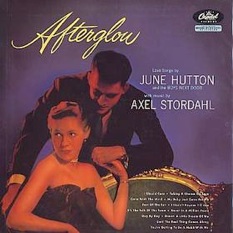
Truth be told, Sinatra actually brought two relationships to pleasant closure with these final visits to the Capitol Tower. He found an end to his LP relationship with Capitol, and he dipped all the way back to his Columbia days to work one last time with Axel Stordahl, with whom he had last worked some 8 years earlier at the very first Sinatra/Capitol session (photo at right). Stordahl, then, would see both ends of the Capitol era: 1.) “Give me a chance to show you I’m not done yet” and 2.) “Get me the hell outta here,” while missing all the fun stuff that came in between.
Sinatra and Stordahl were label-mates at Capitol for a time, but much of Stordahl’s “in between” time was spent working in television and recording for Decca and Dot, moving slightly into the “exotica” oeuvre.
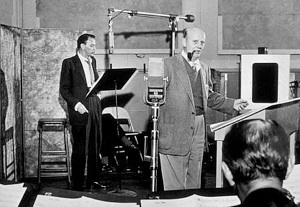

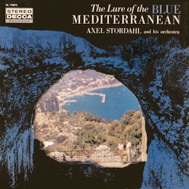

Point of No Return is a sensitively, nuanced, beautifully recorded album, in my opinion, with miking being something along these lines:
Left track: Strings, harp (3 mics total, 2 on the strings, with winds often leaking into the string mics)
Center track: Francis (1 mic)
Right track: French Horns, winds that are not French Horns, bass, celeste, piano, guitar, drum set, percussion (8 mics)
With plenty of leakage (nothing overly-closely miked) and blend, all very tastefully gain-ridden and knob-twiddled as needed during the sessions. This was recorded by a pro’s pro, pure and simple.
Axel Stordahl, and an uncredited Heinie Beau, accomplished some very effective, subtle things on this album, and they are beautifully captured on tape. For instance:
•Vibraphone: This gets used, as far as I can tell, very briefly, and only on two tracks, and on one of those tracks, “These Foolish Things,” the motor is turned off, so it doesn’t even sound like a vibraphone, just a large, generic metallophone, but on “September Song,” at 2:26 and again at 3:32, it very quickly appears in all of its shimmery, spooky glory (in the right channel, partnered perfectly and symmetrically with the harp in the left) after the word “November,” to really add tension to that song. Emil Richards had to drag that thing down to Capitol to play almost-literally two notes, but boy, were they important notes!
•Also in “September Song,” the use of the very high range of the upright bass in the right channel at 3:36. It sounds like a close-miked cello, but it’s not. It’s the upper range of the bass, bowed rather than pizz’d/plucked.
•That gorgeous, soaring French Horn/viola/celli middle section in “There Will Never Be Another You,” like it was designed for stereo: strings on the left, horn on the right, perfectly balanced.
•The tense, very high, very quiet, sustained violins that hover in the background of “Somewhere Along the Way,” starting around the 1:00 mark.
•The spare-but-effective use of timpani on “These Foolish Things.”
And the pièce de résistance, from the arranging pen of Heinie Beau:
•The absolutely brilliant and fragile opening and closing to “I’ll Remember April.” Wow! I could listen to this all day. Slow 2/2 cut time (I think); high violins, pianissimo, harmonizing with each other; Upright bass on the downbeats; the harp filling the gaps left by the bass, but not playing “regular harp stuff” -- Veryle Brilhart is playing harmonics (see below); a pair of flutes, harmonizing in the very lowest, exotic-sounding ranges for that instrument; a bell tree playing a glissando on every other beat; two different triangles accompanying the bell tree on alternating measures; a pair of finger cymbals accompanying on at least one. (Listen to the twelfth “tap,” right before the word “alone,” for the tell-tale double-clang of the finger cymbals.)
Here’s a visual (farther down below) to go with this audio. Watch the chart as the YouTube link plays.
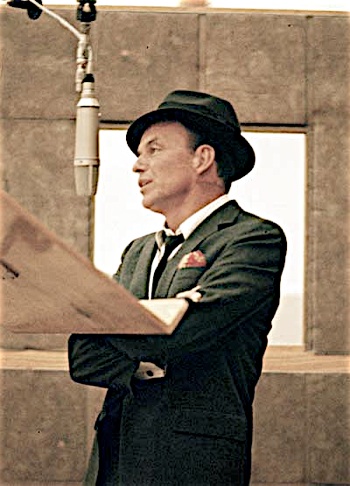
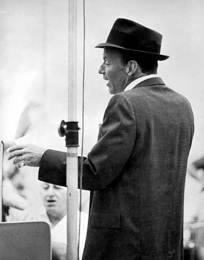

While we’re looking at album covers, there’s something interesting to ponder when looking at covers for Point of No Return, which came in two early editions, and a third reissue version which has since been reused for CD.
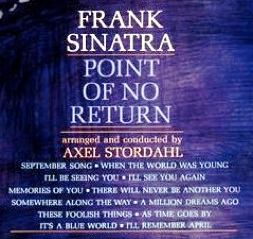
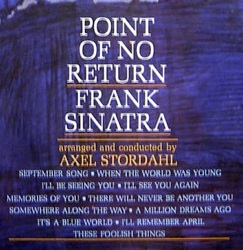
Both covers at left appeared on early 1960s rainbow-label releases, both versions used for both mono and stereo. The version at far left is missing “As Time Goes By,” and artist/title positions are swapped.
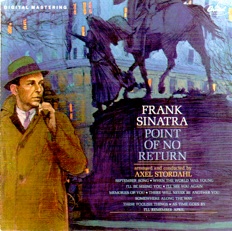
Oddly, and perhaps intentionally in the name of “authenticity,” the 11-track version is featured in current (July, 2013) online advertising for the upcoming MFSL releases (above left). However, MFSL has based its online artwork on the 11-track mono cover, above right, and apparently just digitally squished everything downward, making everything (including Frank) a little shorter and stouter in order to squeeze in the ORIGINAL MASTER RECORDING banner, raising the question: Why not just duplicate an original stereo version (11- or 12-song variety), replacing Capitol’s FULL DIMENSIONAL STEREO banner (left)? And why crop the horse’s head?

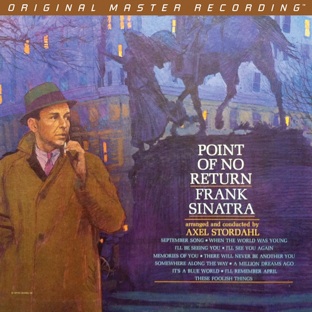
In the 1970s, an abridged, 10-song Capitol LP used another song-title variant (far left), which was errantly reused for CD releases (left).


Note, too, that the rear cover came with two song lists originally:










It’s curious to note that early Australian copies seem to have used the 11-song front and rear covers, while British and French releases used the 12-song varieties, and at least some German copies (below) used the 11-song front cover and 12-song rear cover.


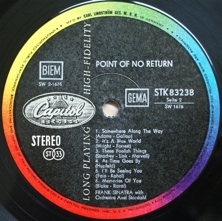
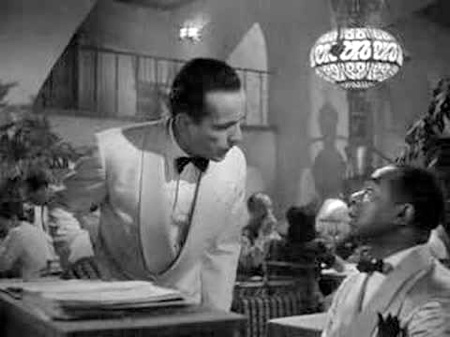
As Time Goes By
“Sam, I thought I told you never to play --”
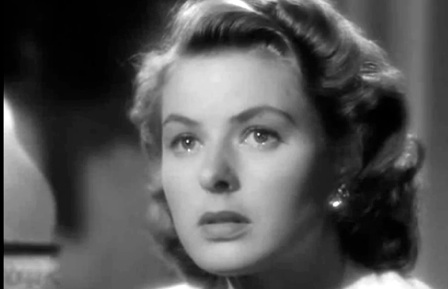
One has to wonder if, perhaps, there was some displeasure with the performance of “As Time Goes By,” dropping the song count from the usual twelve songs down to eleven. No One Cares had faced a similar problem when “The One I Love” was dropped, resulting in an eleven-song LP, so there is certainly precedent for this sort of thing. The fact that both front and rear cover artwork was completed that made no mention of “As Time Goes By” may point in this direction, as may the curious case of the 7” jukebox sets (pictured below) for this album, which included ten songs on five disks, with “As Time Goes By” and “I’ll Remember April” being absent, the latter perhaps being cut only because, since songs travel in pairs on these disks, an eleven-song release was not practical.

While there’s certainly nothing conclusive there, it is a curious situation.
How about the recording of “As Time Goes By?”
There are three obvious splices that are identical on the original stereo and mono mixes. The first 18 seconds are clearly spliced in, with an obvious change in vocal timbre occurring on the first utterance of the phrase “as time goes by.” The second splice is from 1:05-1:28. You can hear this (original mix summed in the left channel; McEowen mix summed in the right channel) by clicking here: AsTimeGoesEdit-DellLeft-RomanceRight.mp3. (This falls within the free-clips section available at iTunes at the bottom of the page.) The third edit is just as aurally obvious, but a little more difficult to pinpoint. As the orchestra disappears around 2:32, Sinatra and pianist Bill Miller take the spotlight again. The 2007 remix by Capitol’s Dave McEowen on the CD Romance Songs from the Heart does not include the second splice, but assumedly continues the main-body-of-the-song take, revealing a different performance that is roughly 10% slower than the one that had been previously released. I think the splice may occur on the final bass “plunk” before Frank enters. Here are a few seconds, with the McEowen remix heard (summed) in the left channel, and the original stereo mix (summed) in the right channel. Notice how the vocal entry happens earlier in the original (right) version. To listen, click AsTimeGoesByLeftMcKeowenRightDell.mp3.
My question is this: How is it that Mr. McEowen managed to get the splice at 0:18 correct, but then did not include the splice at 2:32? I have no answer for that question.
How about the recording of the album in general?
Back on the (now deleted) pages for Sinatra’s Swingin’ Session, I referred to that 1960 recording as a “new phase” Capitol recording, with more mics feeding a bigger, twelve-input console, resulting in a closer-miked, more “present” and crystalline sound. Come Swing with Me continued this approach, again in a swinging vein, while Point of No Return finishes the trio of “new phase” albums, the only string-centric LP of the three, and what a fine recording this is: Strings shimmer, finger cymbals and bell trees sound close while keeping their appropriately light qualities, brass are appropriately 1949 Columbia Records “corn-fed” sounding when needed, while woodwinds are intentionally, wistfully distant, and the linchpin, Sinatra’s vocal, recorded for what was probably the first time on a Neumann U67, is tonally rich and just airy enough to keep the more melancholic sides from dipping into No One Cares territory.
....and the piano plays in unison with the flutes on some measures, too!
What is giving the harp that unsual, tensile sound? Click on the video below to find out:
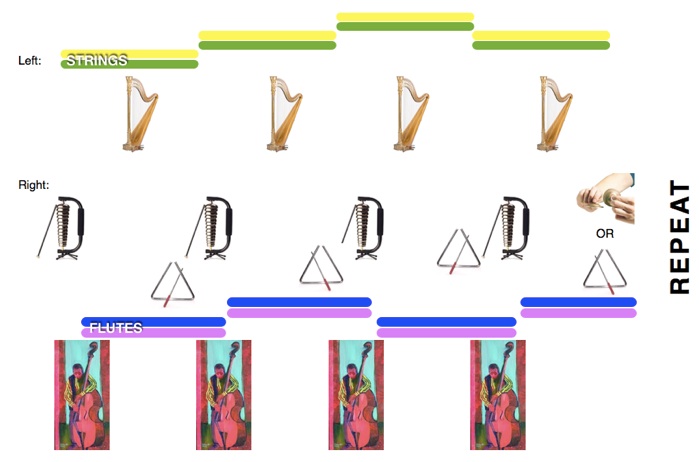

Tape Splices
This album may have as many audible splices as all the other Sinatra/Capitol “concept” albums put together. Here are ones that I’ve spotted, and I may have missed some!
•Memories of You - 2:08.
•When the World was Young - 3:25
•These Foolish Things - 2:50, 3:38
•As Time Goes By - 0:18, 1:05, (1:17?) 1:28, and either a splice or crossfade at 2:33
•It’s a Blue World - 1:50
•I’ll Remember April - 1:45
•I’ll Be Seeing You - I think 1:26-1:31 is an insert.
Of course, it is certainly possible that MFSL will alter the artwork on the actual release when the time comes.
Update, December 2, 2013: What a prophetic statement that (unintentionally) turned out to be! The MFSL release offers us an entirely new variant on the album cover’s text layout. Specifically:

For the first time, we have this combination of elements:
•Point of No Return above Frank Sinatra
•Both of those elements in the same white-ish color
•Complete, 12-song tracklist
To my knowledge, this combination of elements did not exist previously for this album, so this is essentially a “hybrid” of past versions, newly created.
COOL!


